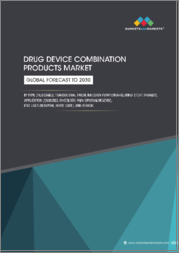
|
시장보고서
상품코드
1671812
세계의 경피 패치 시장 : 시장 기회, 패치 용량, 가격, 임상시험 동향(2030년)Global Transdermal Patch Market Opportunity, Patch Dosage, Price & Clinical Trials Insight 2030 |
||||||
세계 경피 패치 시장 규모는 2030년까지 180억 달러에 달할 것으로 예상됩니다. 현재 미국이 세계 경피 패치 시장을 독점하고 있으며, 그 규모는 40억 달러 이상입니다. 2030년까지 중국이 경피 패치의 성장 시장으로 부상할 것으로 예상됩니다.
세계 경피 패치 시장은 역동적이고 치열한 경쟁의 장으로 빠르게 변모하고 있으며, 스타트업과 기존 기업 모두 환자의 증가하는 수요에 대응하기 위해 끊임없는 기술 혁신을 하고 있습니다. 이러한 패치는 피부를 통해 치료 약물의 제어되고 안정적인 방출을 촉진하여 통증 관리, 금연, 호르몬 대체요법 등 다양한 질환을 치료하는 데 도움을 줍니다. 대표적인 성공 사례는 2000년대 초 금연 보조제로 인기를 끌었던 니코틴 패치입니다. 이후 경피 패치로 치료할 수 있는 증상의 범위가 상당히 넓어졌으며, 현재는 ADHD, 호르몬 결핍증, 메스꺼움 등의 치료도 포함하게 되었습니다. 경피 패치는 기존의 약물전달 방법에 비해 비용이 많이 드는 경향이 있지만, 유리한 안전성과 유효성 프로파일에 힘입어 지속적으로 시장 성장을 촉진하고 있습니다.
세계 경피 패치 시장 확대를 위해서는 규제 당국의 승인 획득이 필수적입니다. 규제 당국의 승인 획득은 경피 패치의 약물전달로서의 신뢰성을 확인하는 데 있어 매우 중요합니다. 예를 들어, Zydus Lifesciences는 2024년 8월 FDA로부터 메스꺼움과 구토 치료를 위한 스코폴라민 경피흡수 시스템에 대한 최종 승인을 받았습니다. 마찬가지로, Sino Biopharmaceutical은 2024년 9월 경증에서 중등도의 알츠하이머병 치료를 위한 리바스티그민 경피흡수 패치 제제에 대한 NMPA 승인을 획득했습니다. 이번 승인은 중국에서 판매 허가를 받은 최초의 국산 리바스티그민 패치제이며, 경피흡수형 패치제가 전 세계적으로 받아들여지고 있다는 것을 보여주는 중요한 성과입니다.
경피 패치의 상업적 가능성은 약물전달 시스템의 지속적인 기술 혁신으로 인해 더욱 크게 향상되고 있습니다. 예를 들어, Anodyne Nanotech의 HeroPatch(TM) 플랫폼은 세마글루티드를 포함한 GLP-1 수용체 작용제의 경피 투여에서 50% 이상의 생체 이용률을 달성하여 유망한 전임상시험 결과를 입증했습니다. 이러한 발전은 기존의 주사를 대체할 수 있는 주 1회 바늘 없는 투여 방법을 제공함으로써 당뇨병과 같은 만성질환의 관리를 혁신적으로 변화시킬 수 있을 것으로 기대됩니다. HeroPatch(TM)의 임상시험은 2025년에 시작될 예정이며, 약물전달 기술에서 경피 패치의 역할이 더욱 중요해질 것으로 예상됩니다.
현재 여러 경피 패치가 임상시험 중에 있으며, 이는 약물전달에 있어 이 방법의 큰 잠재력을 강조하고 있습니다. 이러한 패치는 만성 통증 관리, 당뇨병 치료, 백신 접종 등 다양한 치료 분야에서 연구되고 있습니다. 이미 70개에 가까운 경피흡수 패치가 전 세계적으로 승인을 받았으며, 시장의 성장 궤도는 강력할 것으로 보입니다. 피부 자극과 한 장의 패치로 고용량의 약물을 전달하는 데 한계가 있지만, 연구자들은 이러한 문제를 해결하기 위해 노력하고 있습니다. 경피 패치의 전망은 유망하며, 약물 처방, 패치 디자인, 환자 순응도의 지속적인 개선이 시장 성장을 더욱 촉진할 것으로 예상됩니다.
세계의 경피 패치 시장에 대해 조사했으며, 시장 개요와 함께 약제 동향, 임상시험 동향, 지역별 동향, 시장 진입 기업의 경쟁 상황 등을 전해드립니다.
목차
제1장 경피 패치 소개
제2장 경피 흡수 패치의 분류
- 접착제의 단층/다층 약제
- 레저버 경피 패치
- 매트릭스 기반 경피 패치
- 증기 패치
- 액티브 및 패시브 패치
제3장 경피 패치별 약물전달 메커니즘
- 경피 치료제의 특성
- 경피 패치 성분
- 멀미, 니코틴, 여성 피임용 경피 패치의 메커니즘
- 경피 패치와 기존 약물전달 방법 비교
제4장 세계의 경피 패치 시장 전망
- 현재 시장 시나리오
- 향후 시장 기회
제5장 지역별 세계의 경피 패치 시장 동향
- 미국
- 유럽
- 중국
- 일본
- 한국
- 영국
제6장 기업별, 적응증별, 상별 세계의 패치 임상 파이프라인
- 연구
- 전임상
- 제1상
- 제I/II상
- 제II상
- 제III상
- 사전 등록
- 등록
제7장 세계적으로 판매되고 있는 경피 흡수 패치의 임상적 인사이트
제8장 심혈관질환용 경피 패치 - 시장 가용성, 용량, 가격 분석
- 니트로글리세린 경피 패치
- 클로니딘 경피 패치
- 비소프로롤 경피 패치(비소노)
제9장 경피 진통 패치 - 시장 가용성, 용량, 가격 분석
- 펜타닐 경피 패치
- 부프레노르핀 경피 패치
- 디클로페낙 경피 패치
- 케토프로펜 경피 패치(Mohrus)
- 리도카인 경피 패치
- 캡사이신 경피 패치(Qutenza)
- 메틸 살리케이트 경피 패치
- 글리콜살리실산 경피 패치(Tokuhon E)
- 플루비프로펜 경피 패치
제10장 호르몬 요법의 경피 패치 - 시장 가용성, 용량, 가격 분석
- 에스트라디올 경피 패치
- 테스토스테론 경피 패치(Androderm)
- 에스트라디올/노에티스테론 경피 패치
- 에스트라디올/레보노르게스트렐 경피 패치
- 에티닐에스트라디올/레보노르게스트렐(Twirla)
- 에티닐에스트라디올/게스트덴(Apleek)
제11장 신경질환용 경피 패치 - 시장 가용성, 용량, 가격 분석
- 스코폴라민 경피 패치(Transderm-Scop)
- 세레길린 경피 패치(Emsam)
- 메틸페니데이트 경피 패치(Daytrana)
- 덱스트로암페타민 경피 패치(Xelstrym)
- 브로난세린 경피 패치(Lonasen)
- 아세나핀 경피 패치(Secuado)
- 리바스티그민 경피 패치
- 로티고틴 경피 패치(Neupro)
- 로피니롤 염산염(Haruropi Tape)
- 도네페질 경피 패치(Adlarity)
제12장 기타 증상에 대한 패치 - 시장 가용성, 용량, 가격 분석
- 니코틴 경피 패치(Nicoderm CQ/Nicotinell TTS)
- 옥시부티닌 경피 패치(Oxytrol/Kentera)
- 그라니세트론 경피 패치(Sancuso)
- 에메다스틴 경피 패치(Allesaga)
- 피브린 실란트 경피 패치
- 5-아미노레불린산 경피 패치(Alacare)
- 투로부테롤 경피 패치
제13장 세계의 경피 패치 시장 역학
제14장 경쟁 구도
- AbbVie
- Bayer HealthCare Pharmaceuticals
- Corium International
- Endo Pharmaceuticals
- Hisamitsu Pharmaceutical
- Luye Pharma
- Noven Pharmaceuticals
- Novartis
- Purdue Pharma
- Scilex Pharmaceuticals
- Searchlight Pharma
- Somerset Pharmaceuticals
- Teikoku Seiyaku
- Teva Pharmaceuticals
- UCB
- DURECT Corporation
- Senju Pharmaceutical
Global Transdermal Patch Market Opportunity, Patch Dosage, Price & Clinical Trials Insight 2030 Report Highlights & Findings:
- Global Transdermal Patch Market Opportunity: US$ 18 Billion By 2030
- US Currently Dominating Global Transdermal Patch Market: > US$ 4 Billion
- China To Emerge Growing Market For Transdermal Patches By 2030
- Currently More Than 60 Patches Are Approved Globally
- Approved Patches Market Availability, Dosage & Price Analysis
- Global Transdermal Market Insights By Region & Indications
- Comprehensive Insight On Clinical Trials By Company, Indication & Phase
- Competitive Landscape: Insight On Key Companies
The global market for transdermal patches has rapidly transformed into a dynamic and intensely competitive arena, where both emerging players and established firms are continually innovating to address the increasing demands of patients. These patches facilitate a controlled and consistent release of therapeutic agents through the skin, serving a diverse array of medical conditions, including pain management, smoking cessation, hormone replacement therapy, and more. An outstanding example of their success is the nicotine patch, which gained popularity as a smoking cessation aid in the early 2000s. Since then, the spectrum of conditions treated by transdermal patches has broadened considerably, now encompassing treatments for ADHD, hormone deficiencies, and nausea, among others. Although they tend to be pricier than conventional drug delivery methods, transdermal patches are witnessing consistent market growth, propelled by their advantageous safety and efficacy profiles.
An essential element in the ongoing expansion of the global transdermal patch market is the attainment of regulatory approval. Successful validations from regulatory authorities are crucial in affirming the credibility of transdermal patches as a viable drug delivery system. For example, Zydus Lifesciences received the final FDA approval for its scopolamine transdermal system aimed at treating nausea and vomiting in August 2024. Likewise, Sino Biopharmaceutical obtained NMPA approval in September 2024 for its rivastigmine transdermal patch, intended for the treatment of mild to moderate Alzheimer's disease. This approval represents a significant achievement, as it is the first domestically manufactured rivastigmine patch authorized for sale in China, emphasizing the increasing acceptance of transdermal patches on a global scale.
The commercial viability of transdermal patches is further enhanced significantly by ongoing innovations in drug delivery systems. For instance, Anodyne Nanotech's HeroPatch(TM) platform has demonstrated encouraging preclinical outcomes in the transdermal administration of GLP-1 receptor agonists, including semaglutide, achieving over 50% bioavailability. This advancement has the potential to transform the management of chronic diseases such as diabetes by providing a needle-free, weekly alternative to traditional injections. Clinical trials for the HeroPatch(TM) are anticipated to commence in 2025, reinforcing the role of transdermal patches as a pivotal element in drug delivery technology.
In another momentous development, researchers at Central South University in China have created a long-acting transdermal delivery system for Guanfacine, a non-stimulant medication for ADHD. This patch is designed to enhance drug release and ensure skin safety, with the capability of supporting treatment cycles lasting up to three days, thus offering a more convenient and patient-centric solution. Furthermore, Biotts, a Polish company specializing in drug delivery, is developing an insulin transdermal patch utilizing its MTC-Y carrier technology. This innovation allows for insulin delivery over a period of up to five days, providing a stable and extended alternative to the daily injections typically required by individuals with type 1 diabetes. Positive results from animal studies have been reported, and Biotts aims to begin human trials by 2027, which could significantly improve diabetes management for countless patients.
At present, there are multiple transdermal patches undergoing clinical trials, highlighting the significant potential of this method for drug delivery. These patches are being investigated across a growing array of therapeutic areas, such as chronic pain management, diabetes treatment, and even vaccination. With nearly 70 transdermal patches already receiving global approval, the market's growth trajectory appears strong, driven by technological advancements and an expanding spectrum of treatable conditions via transdermal means. Although challenges remain, including skin irritation and limitations in delivering higher drug dosages through a single patch, researchers are making progress in addressing these issues. The outlook for transdermal patches is promising, with ongoing enhancements in drug formulation, patch design, and patient adherence anticipated to further propel market growth.
In conclusion, transdermal patches are on the verge of becoming a widely accepted drug delivery method, providing considerable advantages in terms of patient convenience, reliable therapeutic delivery, and minimized side effects. As the market continues to grow, the clinical and commercial success of transdermal patches is expected to significantly influence the global pharmaceutical landscape, offering patients and healthcare providers more effective, less invasive, and more user-friendly alternatives to conventional drug delivery systems.
Table of Contents
1. Introduction To Transdermal Patch
- 1.1 Overview Of Transdermal Patch
- 1.2 Relevance Of Transdermal Patch
2. Transdermal Patches Classification
- 2.1 Single/ Multiple Layer Drug In Adhesive
- 2.2 Reservoir Transdermal Patches
- 2.3 Matrix Based Transdermal Patches
- 2.4 Vapor Patch
- 2.5 Active & Passive Patch
3. Mechanism Of Transdermal Patch Drug Delivery
- 3.1 Properties Of Transdermal Therapeutics
- 3.2 Components Of Transdermal Patch
- 3.3 Mechanism Of Motion Sickness, Nicotine & Female Contraceptive Transdermal
Patch
- 3.4 Transdermal Patch v/s Traditional Drug Delivery Methods
4. Global Transdermal Patch Market Outlook
- 4.1 Current Market Scenario
- 4.2 Future Market Opportunity
5. Global Transdermal Patch Market Trends By Region
- 5.1 US
- 5.2 Europe
- 5.3 China
- 5.4 Japan
- 5.5 South Korea
- 5.6 UK
6. Global Patch Clinical Pipeline By Company, Indication & Phase
- 6.1 Research
- 6.2 Preclinical
- 6.3 Phase-I
- 6.4 Phase-I/II
- 6.5 Phase-II
- 6.6 Phase-III
- 6.7 Preregistration
- 6.8 Registered
7. Global Marketed Transdermal Patch Clinical Insight
8. Transdermal Patches For Cardiovascular Diseases - Market Availability, Dosage & Price Analysis
- 8.1 Nitroglycerin Transdermal Patch
- 8.1.1 Nitro-Dur
- 8.1.2 Nitro TD Patch A
- 8.1.3 Generic Nitroglycerin Transdermal Patch
- 8.2 Clonidine Transdermal Patch
- 8.2.1 Catapres-TTS
- 8.2.2 Generic Clonidine Transdermal Patch
- 8.3 Bisoprolol Transdermal Patch (Bisono)
9. Transdermal Analgesic Patches - Market Availability, Dosage & Price Analysis
- 9.1 Fentanyl Transdermal Patch
- 9.1.1 Duragesic/Durogesic
- 9.1.2 Durotep MT
- 9.1.3 OneDuro
- 9.1.4 Generic Fentanyl Transdermal Patch
- 9.1.5 Fentos
- 9.1.6 Fentadur
- 9.1.7 Generic Fentanyl Citrate Transdermal Patch
- 9.2 Buprenorphine Transdermal Patch
- 9.2.1 Butrans
- 9.2.2 Bunov
- 9.2.3 Sevodyne
- 9.2.4 Transtec
- 9.2.5 Generic Buprenorphine Transdermal Patch
- 9.3 Diclofenac Transdermal Patch
- 9.3.1 Zicthoru
- 9.3.2 Flector
- 9.3.3 Licart
- 9.4 Ketoprofen Transdermal Patch (Mohrus)
- 9.5 Lidocaine Transdermal Patch
- 9.5.1 Versatis
- 9.5.2 ZTlido
- 9.5.3 Penles
- 9.5.4 Rapydan
- 9.6 Capsaicin Transdermal Patch (Qutenza)
- 9.7 Methyl Salicate Transdermal Patch
- 9.7.1 Salonpas
- 9.7.2 Tokuhon
- 9.8 Glycol Salicylate Transdermal Patch (Tokuhon E)
- 9.9 Flurbiprofen Transdermal Patch
- 9.9.1 Loqoa
- 9.9.2 Yakuban Tape
- 9.9.3 Transact Lat
10. Transdermal Patch In Hormonal Therapy - Market Availability, Dosage & Price Analysis
- 10.1 Estradiol Transdermal Patch
- 10.1.1 Alora
- 10.1.2 Vivelle-Dot
- 10.1.3 Minivelle
- 10.1.4 Climara
- 10.1.5 Menostar
- 10.1.6 FemSeven
- 10.1.7 Estrana
- 10.1.8 Generic Estradiol Transdermal Patch
- 10.2 Testosterone Transdermal Patch (Androderm)
- 10.3 Estradiol/ Norethisterone Transdermal Patch
- 10.3.1 Xulane/Ortho Evra
- 10.3.2 Combipatch
- 10.3.3 Menoaid Combi Patch
- 10.3.4 Evorel Conti
- 10.4 Estradiol/Levonorgestrel Transdermal Patch
- 10.5 Ethinyl Estradiol/Levonorgestrel (Twirla)
- 10.6 Ethinyl Estradiol/Gestodene (Apleek)
11. Transdermal Patches For Neurological Disorders - Market Availability, Dosage & Price Analysis
- 11.1 Scopolamine Transdermal Patch (Transderm-Scop)
- 11.2 Selegiline Transdermal Patch (Emsam)
- 11.3 Methylphenidate Transdermal Patch (Daytrana)
- 11.4 Dextroamphetamine Transdermal Patch (Xelstrym)
- 11.5 Blonanserin Transdermal Patch (Lonasen)
- 11.6 Asenapine Transdermal Patch (Secuado)
- 11.7 Rivastigmine Transdermal Patch
- 11.7.1 Exelon
- 11.7.2 Generic Rivastigmine Transdermal Patch
- 11.8 Rotigotine Transdermal Patch (Neupro)
- 11.9 Ropinirole Hydrochloride (Haruropi Tape)
- 11.10 Donepezil Transdermal Patch (Adlarity)
12. Patches For Other Conditions - Market Availability, Dosage & Price Analysis
- 12.1 Nicotine Transdermal Patch (Nicoderm CQ/ Nicotinell TTS)
- 12.2 Oxybutynin Transdermal Patch (Oxytrol/Kentera)
- 12.3 Granisetron Transdermal Patch (Sancuso)
- 12.4 Emedastine Transdermal Patch (Allesaga)
- 12.5 Fibrin Sealant Transdermal Patch
- 12.5.1 Evarrest
- 12.5.2 TachoSil
- 12.6 5-Aminolevulinic Acid Transdermal Patch (Alacare)
- 12.7 Tulobuterol Transdermal Patch
- 12.7.1 Tulo-Touch
- 12.7.2 Hokunarin
13. Global Transdermal Patch Market Dynamics
- 13.1 Favorable Market Parameters
- 13.2 Commercialization Challenges
14. Competitive Landscape
- 14.1 AbbVie
- 14.2 Bayer HealthCare Pharmaceuticals
- 14.3 Corium International
- 14.4 Endo Pharmaceuticals
- 14.5 Hisamitsu Pharmaceutical
- 14.6 Luye Pharma
- 14.7 Noven Pharmaceuticals
- 14.8 Novartis
- 14.9 Purdue Pharma
- 14.10 Scilex Pharmaceuticals
- 14.11 Searchlight Pharma
- 14.12 Somerset Pharmaceuticals
- 14.13 Teikoku Seiyaku
- 14.14 Teva Pharmaceuticals
- 14.15 UCB
- 14.16 DURECT Corporation
- 14.17 Senju Pharmaceutical



















